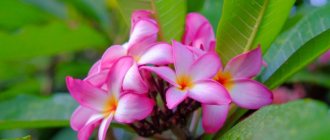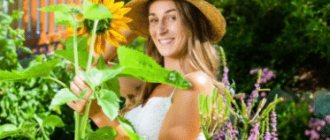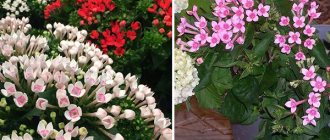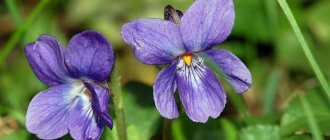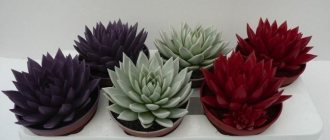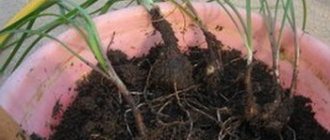Happy travelers, returning from the Hawaiian Islands or Indonesia, having visited Goa, Bali or Laos, fondly remember necklaces and garlands of large fragrant flowers, which are used in these countries to decorate rooms and create a festive atmosphere. They are made from plumeria. There is great news: plumeria can be successfully kept at home, and there are no problems purchasing seeds. Caring for an exotic plant is not as difficult as expected. Spectacular flowers, an attribute of the tropics, can be admired without long journeys!
What does plumeria look like?
Plumeria is a spreading, very beautifully flowering shrub or tree of the Kutrovaceae family, the national symbol of Bali and Laos. In these countries it is better known as frangipani.
This is interesting! The name frangipani comes from the name of the Italian perfumer Maurizio Frangipani, who successfully used plumeria flowers to create perfumes. This was in the 16th century. Since then, the aroma of frangipani began a triumphal march in France: entire royal dynasties were fond of it. One of the fans was Catherine de Medici herself.
When cut, plumeria flowers retain their freshness and presentable appearance for a long time. The famous Hawaiian wreaths (leis) are made from plumerias. In addition to Bali, Laos, Indonesia and Hawaii, plumeria grows naturally in Thailand, Mexico, Texas, Florida, California, and India.
In suitable climatic conditions, plumeria also grows outdoors.
Large five-petal flowers amaze with combinations of colors and delicate aroma. Flowers of different varieties can be white, yellow, orange, pink, red, purple. Under favorable conditions, plumeria will delight you with long and abundant flowering even at home.
Plumeria leaves, like the flowers, are very showy. Large, rigid, elliptical or lanceolate in shape, they can be glossy or slightly pubescent. They grow in bunches at the ends of shoots. May be dark green, reddish or grayish.
Plumeria is heat-loving, so it can grow in open ground only if climatic conditions permit. Decorates streets and is widely used in landscape design. As such, it is popular in the USA, Thailand and Indonesia. In our conditions, plumeria feels good in bright, heated rooms, with diffused natural light. Because mature plants have strong root systems, they are often kept in large containers. The spectacular tree, which is covered in tropical flowers in spring, delights residents of cool latitudes.
Plumeria is not only a holiday tree. Her image in the mythology of different nations also has all sorts of dark meanings. The smell of plumeria flowers in the scary tales of the islanders serves as a harbinger of the coming of a vampire.
Photo gallery: blooming plumeria - an incredible variety of shades
Plumeria is also known around the world under another name - frangipani.
The heart note of some modern perfumes includes plumeria.
White and pink varieties have the most intense aroma
Plumeria flowers are used in modern cosmetology
Plumeria flowers often combine shades of pink and yellow.
These flowers do not smell as intensely as white and yellow varieties.
general information
The second name for plumeria is frangipani. This is a tall and fast-growing perennial with beautiful leathery leaves and showy flowers up to 10 cm in diameter. Plumeria blooms from mid-summer to mid-autumn. Although in its native tropics it can bloom almost all year round.
Under natural conditions, plumeria is a powerful branched tree that grows to impressive proportions. The shape and shade of the leaves depend on the specific species. The aroma of five-petal flowers is reminiscent of jasmine or lily of the valley with citrus notes.
Remember that plumeria juice is toxic and can cause severe irritation. So it is better to do replanting and pruning while wearing gloves. In some countries, for example in Thailand, plumeria is a sacred ritual flower.
Photo: pixabay.com
Selecting a variety and purchasing seeds
Many online stores will gladly sell you the seeds of this beautiful plant. They remain viable for a long time, so there is no need to look for a fresher product. Which variety should I choose? Are all varieties of plumeria suitable for keeping in an apartment? Choose your plumeria based on size, desired shade, intensity of flower aroma and leaf tone.
Plumeria flowers lack nectar. Insects, deceived by the appearance and aroma of flowers, do not find food in their corollas.
You can adjust the size of the plant by pruning the roots and shaping the crown. Therefore, you should not be afraid that the flower will grow excessively. Nevertheless, there are dwarf varieties of plumeria, which are more convenient to maintain than full-sized plants.
Dwarf and semi-dwarf varieties of plumeria:
- Plumeria alba (white);
- Plumeria cubensis (Cuban);
- Plumeria obtusa var. sericifolia (silk-leaved);
- Plumeria pudica (bashful);
- Plumeria rubra Aphrodite (red Aphrodite);
- Plumeria stenophylla (narrow-leaved).
All varieties of plumeria bloom with fragrant flowers.
It is known that white and yellow plumeria flowers have a stronger scent than purple, pink and red ones.
The following varieties of plumeria have white, orange and yellow flowers:
- Plumeria rubra JL Pupukea Crepe;
- Plumeria rubra JL Rim Fire;
- Plumeria rubra Summer Moon;
- Plumeria rubra Sweet Fragrance;
- Plumeria rubra Vanilla Pudding;
- Plumeria rubra Cindy Moragne;
- Plumeria rubra Moragne #23;
- Plumeria rubra Beautiful Thailand;
- Plumeria rubra Orange Unique;
- Plumeria rubra Star Dust.
Plumeria with flowers of red, pink, purple shades
If you want to grow a plant not only with beautiful flowers, but also with beautiful white-green or yellow-green leaves, choose a variegated plumeria variety.
- Plumeria rubra Loi Kratong;
- Plumeria rubra Luan Manee;
- Plumeria rubra Passion;
- Plumeria rubra Petra;
- Plumeria rubra Sangwaan Tabtim;
- Plumeria rubra Silk Road Spice;
- Plumeria rubra 4646;
- Plumeria rubra Allure;
- Plumeria rubra Aphrodite;
- Plumeria rubra Charlotte Ebert;
- Plumeria rubra Chompoo Wang;
- Plumeria rubra Compacta Rosa;
- Plumeria rubra Courtade Pink;
- Plumeria rubra Deep Desire;
- Plumeria rubra Delicate Bouquet;
- Plumeria rubra Festival;
- Plumeria rubra Fire Rain;
- Plumeria rubra Francoise;
- Plumeria rubra Fujisan;
- Plumeria rubra Hin Muang;
- Plumeria rubra Muang Ongcarak;
- Plumeria rubra Purple Serendipity;
- Plumeria rubra Siam Lavender.
Garlands of plumeria flowers accompany all significant events in the life of aborigines in tropical countries: births, marriages, funerals. In Bali, plumeria flowers, as an integral attribute of funerals and weddings, symbolize the transition from life to death and vice versa. Therefore, the plant is planted at temples and is called a temple tree.
Not all varieties of plumeria are listed: there are many more. Selection work is constantly being carried out to develop new hybrids. Order seeds from an online store, focusing on advertising catalogues, but don’t be too upset if the plant does not grow very similar to the chosen picture.
Spectacular specimen with yellow-green leaves
Kinds
White plumeria / Plumeria alba
It grows naturally in the Antilles. These trees grow up to 10 m in height. The leaves are linear in shape, the underside of the leaf blade is densely covered with white hairs, the edges of the leaf are slightly raised; the leaf reaches 30 cm in length and up to 7 cm in width. The flowers smell very pleasant, not very large - up to 2.5 cm in diameter, white with a yellow eye.
- Indoor vines
Red plumeria / Plumeria rubra
Grows mainly in Venezuela and Mexico. Trees shorter than white plumeria are up to 5 m in height, deciduous. The leaves are ovoid, up to 15 cm wide, almost 0.5 m long; the underside of the leaf can be both pubescent and smooth; The apex of the leaf is usually blunt, but can also be sharply pointed. The flowers are collected in clusters at the top of the shoots, up to 5 cm in diameter. Depending on the variety, the flowers are pink, white, red, yellow, and purple. The shape of the leaves may differ among different varieties.
Flower propagation by cuttings
Semi-lignified plumeria cuttings are stored for a long time - up to three months. They tolerate shipping well, and also transfer 100% of the properties of the mother plant. Online stores send out both seeds and cuttings of plumeria. Concerns regarding the purchase of cuttings are associated with the large difference in climatic conditions in the homeland of the mother plant and in the country of delivery. It can be difficult for the cutting to acclimate. But you can also take cuttings from plants grown in our indoor conditions. Then success is practically guaranteed.
Photo gallery: how to propagate plumeria from cuttings?
Plumeria cuttings are cut from semi-lignified shoots
The appearance of roots is the goal of gardeners who propagate plumeria from cuttings
Sending plumeria cuttings is not difficult
Plumeria cuttings are quite impressive in size: about 30 cm
Plumeria cuttings can be bought without problems in online stores
Harvesting and planting cuttings
It is recommended to cut cuttings when the plant is dormant - in autumn or winter. The optimal length of the cutting is about 25 cm. The cutting should not be green: only semi-lignified.
- Cut the cutting obliquely, at an angle of about 450. An oblique cut will provide more usable space for root formation.
- Tear off the leaves on the cuttings. You can leave flowers.
- Allow the planting material to dry for two weeks outdoors in a warm, dry room.
- After two weeks of drying, the cuttings can be rooted, or you can leave them until spring: they will be perfectly preserved. If rooting will take place outdoors (provided the climate allows), the second option is preferable. In apartment conditions, plumeria can be rooted at any time of the year.
- Prepare the substrate. In a 2-3-liter container, pour in turn a peat mixture for flowering plants with the addition of tree bark and perlite (top and bottom layers), sand or perlite (between them).
- Treat the lower cut of the cutting with a root formation stimulator. It makes sense to treat only about 1 cm of the cutting above the cut: roots form exclusively in the cut area.
- Place the cutting in the substrate and provide it with three important conditions: not too high substrate humidity, lower heating and rest.
- Water moderately: keep the substrate always moist, but not wet.
- A little heating from below (a shoe dryer will do) is exactly what your plant needs now to form roots.
- A prerequisite for successful rooting is complete immobility of the cutting. Newly formed roots are easily torn even by slight movement.
- Sunlight is very useful for rooting - together with bottom heating, it stimulates the formation of roots. This is an argument in favor of storing cuttings cut in autumn and winter until spring. Your plumeria will definitely like it on a sunny windowsill.
If all these recommendations are followed properly, after 45–70 days you can expect successful rooting of the plumeria cuttings. How to understand that everything worked out? By the formation of new leaves. The appearance of flowers, unfortunately, is not an indicator of success: the cutting can bloom without any connection with the formation of new roots.
This is interesting! Plumeria flowers are used in modern cosmetics and perfumes. Their extract has anti-inflammatory, regenerating properties, and is included in many face and body creams. The aroma of frangipani is still popular today. Its note is included in the heart of a bouquet of popular perfumes and is considered the aroma of seduction and lust. Perfumes with the corresponding “heart note”: Serpentine Roberto Cavalli, Champaca Absolute Tom Ford, Acqua 33 Emilio Pucci, Annick Goutal Songes and others. Plumeria oil can be purchased as “champa oil” and used externally as an anti-inflammatory and aphrodisiac (caution: there are contraindications).
Video: flower propagation by cuttings
What to do after purchase?
Simply bringing plumeria home, placing it and watering it will not work. So she will definitely die. And you shouldn’t forget about it for a few days after purchase either. The plumeria was looked after in the store; it seemed to “get used” to it. Therefore, you cannot slow down and think that if you leave her without care for a while, nothing will happen.
The first thing you need to do at home after purchasing plumeria is to remove its packaging, protective film and everything else that blocks the access of oxygen and air to the plant as a whole.
Next, you need not to take a photo of the plumeria, no matter how beautiful it may be, but you need to remove dried branches and leaves, as well as buds and already blooming inflorescences with pruners. The fact is that they grew only thanks to a large amount of fertilizer, and in room conditions, even with proper care, they will no longer grow.
You also need to plant the rose in different containers if it consists of several bushes, since they will interfere with each other. And, of course, you need to treat the plant with a drug against diseases and pests as a preventative measure to prevent the development of infectious and fungal diseases.
Germination of seeds
Plumeria seeds can be the result of either cross-pollination or self-pollination. Accordingly, a new plant can have a very unexpected appearance.
Young plumeria grown from seeds adapt better to the climate of their new homeland, but, unfortunately, they may not transmit all the properties of the mother plant.
Growing plumeria from seeds is very interesting. Quite large (about 2 cm) seeds, decorated with “wings”, are convenient for manipulation. To comfortably engage in germination, prepare the following tools and equipment in advance:
- Plastic cups for each seed.
- Container for soaking seeds.
- Water and fungicide.
- Thermometer.
- Substrate for seed germination: light and moisture-permeable. Suitable substrate for succulents or universal soil with baking powder. An alternative is peat tablets.
- Markers-indicators to indicate the variety of sown plants.
- Transparent polyethylene bags for greenhouses.
- Heat source for bottom heating of the substrate: for example, a shoe dryer, heated towel rail, non-hot radiators.
- Cotton wool and toothpicks.
Plumeria seeds in the photo
Plumeria seeds can be sold in sets called “mix”
White and yellow plumerias bloom with very fragrant flowers.
Plumeria seeds are ready for germination
Plumeria seeds are sold in online stores
Each seed is about 2 cm long (not including the “wing”)
Do I need to soak the seeds before planting?
Should plumeria seeds be soaked before planting or not? The procedure has an undoubted advantage, identifying seeds that are too light and will definitely not germinate. Leave them for 18–20 hours in warm water (with bottom heating). You can add a drop of a biostimulant, as well as a fungicide. Floating and unswollen seeds are considered unusable. Another option is soaking in a damp cloth soaked in solutions of a biostimulator and fungicide for the same 18–20 hours.
One of the soaking options: in water with a drop of stimulant
On the other hand, if there is no doubt about the quality of the seeds, they do not need to be soaked. They will germinate without this manipulation, which is confidently stated by plumeria lovers based on their own successful experience.
Sowing seeds
Seeds can be sown in two ways:
- stick it vertically into the substrate, leaving the “wing” and the edge of the seed above the ground;
- lay them horizontally on the substrate, lightly pressing them into the ground and sprinkling them with a little soil, and again leaving a “wing” above the ground.
Both methods are equally effective. The advantage of the second is that the formation of the root can be tracked immediately: the root, rushing deep into the substrate, changes the position of the seed, slightly raising its edge. Even before the sprout appears, you will know in advance about success.
The plumeria seed is already sown in the lower peat tablet with the “wing” facing outwards
Young plumeria seedlings do not tolerate picking and transplanting well, so it is better to provide each plant with a separate plastic cup from the very beginning . If for some reason this is inconvenient, the seeds can be sown in peat tablets, so that later, with comfort for yourself and the plants, you can plant the plumerias in separate containers along with the tablets in which they grow.
This is interesting! In Mayan mythology, plumeria was a symbol of fertility and masculine energy.
Mark the sown seeds with markers on the signs, so as not to get confused later in the varieties you have chosen. Cover the plantings with greenhouses.
Substrate temperature and humidity
Bottom heating in combination with a greenhouse will provide the proper conditions for seed germination: about 30°C and a moist, but not wet substrate. Do not forget to open the plants for 5-7 minutes every 2-3 days for ventilation.
Greenhouse and bottom heating - conditions for successful germination of plumeria seeds
The appearance of sprouts
The seeds may germinate in a few days, but there is a chance that you will have to wait a week and a half to two weeks. The emerging sprouts should be transferred through gradual hardening to maintenance without a greenhouse and lower heating. At the same time, gradually accustom the sprouts to diffused sunlight.
Successful germination of plumeria seeds is a joy for the gardener
What can hinder success?
- Insufficient or too high germination temperature. At temperature conditions below 20°C and above 35°C, seeds may die.
- The seed coat is too hard, which does not fall off in time and interferes with the development of cotyledon leaves. If you do not help the seedling shed this shell in time, it may die. The shell must be removed very carefully: with it, it is easy to tear off the growing point along with the cotyledon leaves. A small piece of cotton wool soaked in water is placed on top of the shell. Wait until the shell is thoroughly wet, and, carefully prying it off with a toothpick, remove it.
The unwanted seed coat should be carefully removed if it does not fall off on its own.
Reviews from flower growers about Plumeria
Plumeria has captivated many gardeners with its beauty. Opinions about this plant can be read below.
- Maryana Dolgaya : “I fell in love with Plumeria as soon as I saw it bloom. I bought cuttings of this beauty from an online store, and also purchased several varieties of seeds. Despite the fact that I expected the cuttings to take a long time to root, they quickly began to grow, and have been delighting me with their flowering for several years now. As for the seeds, the matter is more complicated - they took a long time to germinate, then they were replanted, and they did not produce flowers for a long time (this is how it should be). But last year they bloomed for the first time. Now I have 4 plants growing from cuttings and 3 from seeds - they are very beautiful and unpretentious, so I recommend them all!”
- Anna Pub : “For me there is no better house plant than plumeria. Not only is it beautiful, but it also allows you to control your growth. Whether the crop grows large or small depends on the size of the pot. I have 3 plumerias of different colors growing. One tree is already more than a meter tall, the others a little less. They bloom every year. The flowers are very beautiful, fragrant – the petals look like artificial ones, they look amazing!”
- Olga Vtorova : “Despite the fact that plumeria comes from South America, it is an unpretentious plant that even a novice gardener can grow. I hesitated to buy it for a long time, but then I bought 2 types at once. What I like most about this culture is the flowering and aroma. The tree grows quickly, so it needs to be replanted and fertilized in a timely manner so that there is enough nutrition in the soil.”
Seedling care
A young plumeria is first transplanted when it has its first pair of true leaves. Try to injure the fragile roots as little as possible. It is better, of course, to do without a transfer; in extreme cases, limit yourself to transshipment. It’s great if the plants have mastered the peat tablets with their roots: there will be no discomfort for them when planting.
Mandatory attributes of good care for young plumerias:
- nitrogen fertilizing;
- diffused sunlight;
- timely transplantation into a larger container.
The plant will bloom for the first time in two to three years. There are cases of earlier flowering.
In India, plumeria is Krishna's favorite flower. It is completely devoid of dark symbolic load and symbolizes eternal joy and immortality. Krishna's flower necklaces are apparently woven from plumeria flowers.
Photo gallery: how to replant a flower?
It is more convenient to replant plumeria if the seed germinated in a peat tablet
A peat mixture with the addition of perlite and sand is poured on top of the drainage, then a hole is made for planting young plumeria in a peat tablet.
A peat tablet with a plant is placed in the center of the pot and soil is filled around the edges without deepening the stem
The soil around the plant is carefully crushed
The date of transfer is indicated on the sign using a marker.
The plant is watered
The transplant is completed, the plant can be placed on a sunny windowsill
Video: Plumeria - secrets of care and growing from seeds at home.
Interesting varieties
Most natural varieties are suitable for home growing. Plumeria in a pot slows down its growth so it doesn't grow too big.
- Plumeria red. In the wild, it sheds its leaves in autumn. Flowers with a waxy coating, dense, fragrant, are collected in large inflorescences. The leaves are dark green, oblong.
- White plumeria (Hawaiian). In nature it reaches 4-5 meters in height. Habitat: Caribbean Islands. The leaves are oblong and boat-shaped. The flowers are five-petaled, white with a yellow center. The smell is strong, reminiscent of citrus.
- Plumeria dulled. Another name is adenium. The natural habitat is Africa. An evergreen plant with flowers that exude a citrus aroma. The variety is suitable for bonsai formation.
Important tip! Immediately after purchase, it is not recommended to place the flower in a sunny place. He needs to adapt to new conditions. Keep the plant in a shaded place for about a week, away from other indoor crops. Get used to the sun gradually.
Features of keeping adult plumeria in an apartment
At home, adult plumeria can grow very tall. Or it can remain small: 0.5–1.5 m. It all depends on the variety and care. Plumeria growth can be controlled or stimulated using a special replanting schedule.
Important note! Like all Kutrovye, plumeria is a poisonous plant. Although its flowers are harmless (in India they are even eaten as a cure for fever), the milky sap is poisonous and causes skin irritation. Take this factor into account: take precautions when forming the crown, cutting and transplanting plumeria.
Conditions of detention - table
| Substrate and container | Nutritious loose substrate: a mixture of turf soil, peat, humus, coarse sand. A spacious container if you want your plumeria to grow tall. Tight container if growth must be contained. Container material: plastic is better than ceramic. Plumeria roots grow to the walls of the ceramic pot and are injured during transplantation. Good drainage is needed. |
| Lighting | Diffused sunlight at least 6 hours a day. The plant is shaded from direct sunlight. In summer, it is useful to take plumeria out into the open air, but without drafts. In autumn and winter, the plant is not illuminated: plumeria goes into retirement. |
| Watering | In summer: watering without stagnation of water in the pan. Do not allow the top layer of the substrate to dry out. In winter: regular watering, less often than in summer. Do not allow the earthen clod to dry out completely (it is permissible for the top layer of the substrate to dry out). |
| Transfer | Plumeria is transplanted into increasingly larger containers until it is possible not to restrain the further growth of the plant. The larger the volume of the root system, the taller the tree will grow. Young plumerias are replanted annually, adults - once every two years.
|
| Period of active growth | It begins after a period of dormancy with the growth of new shoots and flowering of the plant. Leaves appear later than flowers. Provide sufficient lighting, increase watering, and start regular fertilizing. |
| Feeding | In spring and summer, during the period of active growth, plumeria is fed once a week. Alternate root feeding and spraying.
When flowering, phosphorus is especially important for plumeria; when growing foliage, nitrogen is especially important. In autumn and winter, the frequency of fertilizing is reduced to one per month. |
| Bloom | In order for plumeria to bloom profusely and for a long time, it is useful for it to provide high air humidity before and during flowering. This is achieved by regularly spraying the shoots. When the flowers appear, avoid getting water on the petals: this will reduce their decorative effect. At this time, it will be useful to place the container with the plant on a tray with wet expanded clay. This way you can achieve the desired air humidity without spraying. |
| Rest period | As a semi-deciduous plant, plumeria partially sheds its leaves during the dormant period (it can occur in both autumn and winter). At this time, watering is slightly reduced. During the dormant period, cuttings are taken from plumeria for propagation. The duration of the rest period is about one month. |
| Crown formation | A procedure necessary for abundant flowering. It stimulates the growth of new shoots on which flowers form. It is carried out immediately after the dormant period, cutting off unaesthetic and dead old shoots. After this, the plumeria blooms with renewed vigor. |
Video: caring for a plant at home
Propagation of plumeria by cuttings
We recommend reading our other articles
- Carrot variety Tushon
- Winter-hardy varieties of peaches
- Do I need to pick off leaves from tomatoes?
- Feeding bees in spring
Amateur flower growers practice propagation by plumeria cuttings. This is a simple method that gives good results.
Cuttings for propagation are taken semi-lignified, 25-30 cm long. The leaves are removed, the cutting itself is cut at an angle. Cuttings are prepared during the plant's dormant period and planted in the ground in early spring. The cuttings are buried 8-10 cm into the soil. Watering is carried out so that the soil has time to dry out. Rooting of cuttings can be observed after 2-3 months.
Once the crop has grown confidently, you can transplant it into a larger pot in which it will be grown. The first flowering is observed in the year of planting or the next.
Propagation of Plumeria by cuttings
Diseases and pests that affect flowers
Fortunately, there are few of them. A tropical plant with poisonous sap hardly attracts parasites. The three most common ailments of indoor plumeria are fungus, root rot and spider mites.
- Fungus manifests itself as blackening of the leaves, which begins with black dots and gradually covers the entire leaf. There can be many affected leaves. They serve as a source of infection for healthy leaves, so diseased leaves are torn off and destroyed. The plant is treated three times, with an interval of 10 days, with a fungicide solution.
Fungus is an immune problem. Its appearance indicates that the plant needs improved living conditions. In this case, the recovered plant will finally get stronger and there will be no relapse.
- Root rot and stem rot develop when overwatering is combined with hypothermia. Plumeria leaves turn yellow and fall off outside the dormant period. If you suspect root rot, reduce watering, provide adequate lighting and proper temperature. It will be useful to use bottom heating. There are no special remedies for plumeria root rot. Adjust the conditions and the plant should cope with the disease on its own.
- Spider mites readily feast on the poisonous juice of the Kutrovs. Activates during the hot season. Plumeria leaves and tender young shoots suffer. Yellow dots appear on the leaves, and microwebs appear between the leaf blades and petioles. Then they shrink and fall off, the ends of the shoots dry out. Spider mites should be combated by spraying the plant with a solution of any acaricide. Treat plumeria twice, with an interval of 10 days, not forgetting the container and substrate. After spraying, it is useful to cover a small plant with a greenhouse for a day so that the evaporation of the chemical under the film will act even more effectively. Spraying is carried out taking into account safety requirements when working with acaricide solutions.
Spider mites are a serious threat to the health of plumeria
Brief description of cultivation
- Temperature . In summer - no higher than 30 degrees, and in winter - no lower than 16 degrees.
- Air humidity . Should be high. The foliage should be regularly moistened with a sprayer.
- Illumination . Bright light is needed at any time of the year.
- Watering . In winter, the plant needs rare watering, but the earthen ball should not dry out completely. In the warm season, the substrate is moistened abundantly.
- Soil mixture . Universal soil mixture for decorative indoor crops. To prepare the substrate, combine humus, peat, leaf and turf soil (2:1:1:2).
- Fertilizer . In the spring and summer, they are fed with a mineral complex in liquid form. Take ½ part of the dosage recommended by the manufacturer.
- Transplant . Young bushes - once a year, and older specimens - once every 2.5 years.
- Reproduction . By cuttings and seed method.
- Features of care . In winter, the plant should be given rest. With the onset of spring, it is necessary to resort to gradually accustoming the bush to bright sunlight. Regular formative pruning is required. In summer, the flower can be moved to fresh air.
Rare indoor plants Plumeria Collection of Sergei Marinkov
